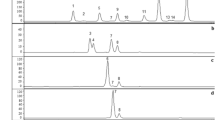Abstract
Berberis lycium Royle (Kashmal) belongs to Berberidaceae family and it has a small edible purple berry. It is grown wildly grown in Himalaya. The berry anthocyanins were characterised by HPLC coupled to a photodiode array (PDA) and mass spectrophotometer (MS) detectors. Twelve anthocyanins were identified in the purified extract of berberis berry. Two anthocyanins delphinidin-3-glucoside (35.3 %) and cyanidin-3-glucoside (47.2 %) were characterized as major components. Ten minor anthocyanins were Cyanidin-3-lathyroside (0.08 %), Cyanidin-3-rutinoside (0.53 %), Cyanidin-3-galactoside (1.62 %), Pelargonidin-3-pentoxilhexoside (2.26 %), Malvidin-3,5-dihexoside (4.21 %), Pelargonidin-hexoside (0.58 %), Pelargonidin- 3,5-diglucoside (1.05 %), Cyanidin-3,5-dihexoside (6.12 %), peonidin-3-rutinoside (0.77 %), pelargonidin-3-rutinoside (0.22 %). Apart from anthocyanins, six phenolics were also identified as chlorogenic acid, coumaric acid, caffeic acid, syringic acid, vanillic acid and quercetin. Antioxidant activity evaluated by DPPH assay revealed IC50 value of anthocyanin was 25.3 μg ml−1. FRAP and CUPRAC assay also gave significant antioxidant activity. MTT assay gave the absorbance of 0.53 at 250 μg ml−1. It may be concluded that the wild berry should be exploited as a source of nutraceuticals for its constitutive phenolics and its activity.





Similar content being viewed by others
References
Andola H, Rawal RS, Rawat MSM, Bhatt ID, Purohit VK (2010) Analysis of berberine content using HPTLC fingerprinting of root and bark of three Himalayan Berberis species. Asian J Biotechnol 2:239–245
Apak R, Guçlu K, Ozyurek M, Esin Karademir S, Ercag E (2006) The cupric ion reducing antioxidant capacity and polyphenolic content of some herbal teas. Int J Food Sci Nutr 57:292–304
Apak R, Kubilay G, Birsen D, Mustafa O, Saliha Esin C, Burcu B, Berker KI, Dilek O (2007) Comparative evaluation of various total antioxidant capacity assays applied to phenolic compounds with the CUPRAC assay. Molecules 12:1496–1547
Benzie IFF, Strain JJ (1996) The ferric reducing ability of plasma (FRAP) as a measure of “antioxidant power”: the FRAP assay. Anal Biochem 239:70–76
Brand-Williams W, Cuvelier ME, Berset C (1995) Use of free radical method to evaluate antioxidant activity. LWT Food Sci Tech 28:25–30
Cao G, Muccitelli UH, Sanchez Moreno C, Prior RL (2001) Anthocyanins are absorbed in glycated forms in elderly women: a pharmacokinetic study. Am J Clin Nutr 73:920–962
Du CT, Francis FJ (1974) Anthocyanins of Roselle (Hibiscus sabdariffa). J Food Sci 38:810–812
Gundogdu M (2013) Determination of antioxidant capacities and biochemical compounds of Berberis vulgaris L. Fruits. Adv Environ Biol 7(2):344–348
Hertog MG, Feskens EJ, Hollman PC, Katan MB, Kromhout D (1993) Dietary antioxidant flavonoids and risk of coronary heart disease: the zutphen elderly study. Lancet 342:1007–1011
Hertog MGL, Aravanis C, Blackburn H, Buzina R, Fidanza F, Giampaoli S, Jansen A, Menotti A, Neddeljkovic S, Pekkarinen M, Simic BS, Toshima H, Feskens EJ, Hollman PCH, Katan MB (1995) Flavonoid intake and long-term risk of coronary heart disease and cancer in the seven countries study. Arch Int Med 155:381–386
Jimenez CDC, Flores CS, He J, Tian Q, Schwart SJ, Giusti MM (2011) Characterization and preliminary bioactivity determination of Berberis boliviana Lechler fruit anthocyanins. Food Chem 128:717–724
Liu Y, Nair MG (2010) An efficient and economical MTT assay for determining the antioxidant activity of plant natural product extracts and pure compounds. J Nat Prod 73(7):1193–1195
Pietta PG (2000) Flavonoids as antioxidants. J Nat Prod 63:1035–1042
Pomilio AB (1973) Anthocyanins in fruits of Berberis buxifolia. Phytochem 12:218–220
Revilla E, Ryan JM, Martín-Ortega G (1998) Comparison of several procedures used for the extraction of anthocyanins from red grapes. J Agric Food Chem 46:4592–4597
Ruiz A, Hermosín-Gutierrez I, Mardones C, Vergara C, Herlitz E, Vega M, von Baer D (2010) Polyphenols and antioxidant activity of calafate (Berberis microphylla) fruits and other native berries from southern Chile. J Agric Food Chem 58:6081–6089
Ruiz A, Hermosín-Gutiérrez I, Vergara C, von Baer D, Zapata M, Hitschfeld A, Obando L, Mardones C (2013a) Anthocyanin profiles in south Patagonian wild berries by HPLC-DAD-ESI-MS/MS. Food Res Int 51(2):706–713
Ruiz A, Mardones C, Vergara C, Hermosín-Gutiérrez I, von Baer D, Hinrichsen P, Dominguez E (2013b) Analysis of hydroxycinnamic acids derivatives in calafate (Berberis microphylla forst) berries by liquid chromatography with photodiode array and mass spectrometry detection. J Chromatogr A 1281:38–45
Sasikumar JM, Maheshu V, Smilin AG, Gincy MM, Joji C (2012) Antioxidant and antihemolytic activities of common nilgiri barberry from south India. Int Food Res J 19(4):1601–1607
Schlesier K, Harwat M, Böhm V, Bitsch R (2002) Assessment of antioxidant activity by using different in vitro methods. Free Rad Res 36(2):177–187
Sood P, Modgil R, Sood M (2010) Physico-chemical and nutritional evaluation of indigenous wild fruit kasmal, Berberis lycium Royle. Ind J Nat Prod Resour 1(3):362–366
Timberlake CF, Bridle P (1982) Distribution of anthocyanins in food plant. Anthocyanins as food colors. Academic Press, Inc., New York, USA, p. 137
Wang H, Cao G, Prior RL (1996) Total antioxidant capacity of fruits. J Agric Food Chem 44:701–705
Wu X, Prior RL (2005) Systemic identification and characterization of anthocyanins by HPLC-ESIMS/MS in common foods in the United States: fruits and berries. J Agric Food Chem 53:2589–2599
Acknowledgments
Authors are thankful to Head, Division of Agricultural Chemicals for providing all the required facilities. Authors are also thankful to Dr. Kaushik Banerjee for his help in LC-MS/MS analysis of phenolics. Authors thank Dr. Jashbir Singh and Dr. Khushbu Sharma for extending their help during the research work.
Author information
Authors and Affiliations
Corresponding author
Ethics declarations
Conflict of interest
There is no conflict of interest between the authors.
Rights and permissions
About this article
Cite this article
Pradhan, P.C., Saha, S. Anthocyanin profiling of Berberis lycium Royle berry and its bioactivity evaluation for its nutraceutical potential. J Food Sci Technol 53, 1205–1213 (2016). https://doi.org/10.1007/s13197-015-2117-4
Revised:
Accepted:
Published:
Issue Date:
DOI: https://doi.org/10.1007/s13197-015-2117-4




